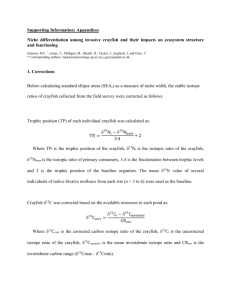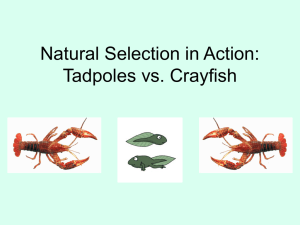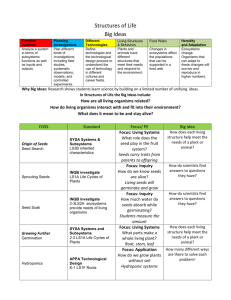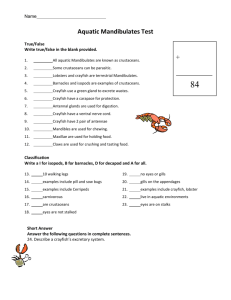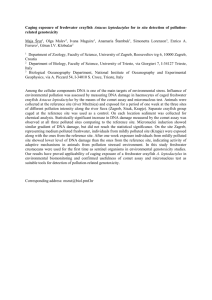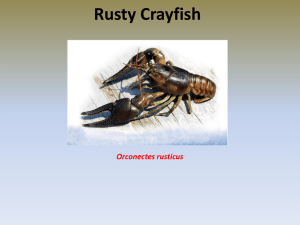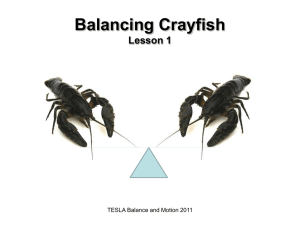jbi12025-sup-0001-AppendixS1-S3
advertisement
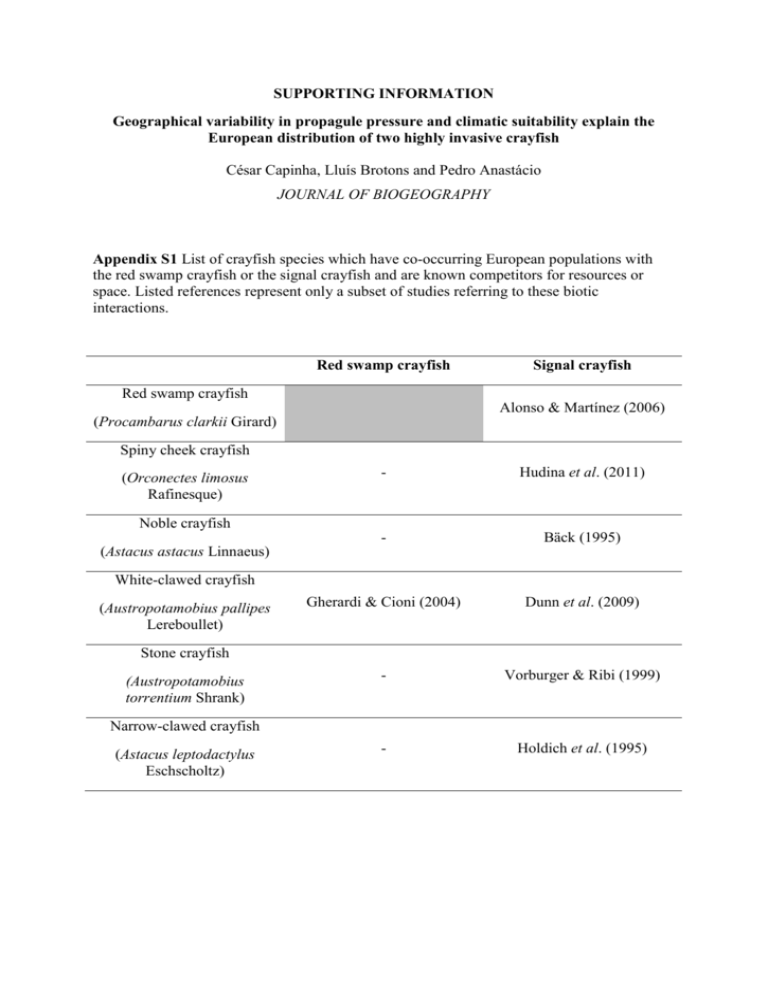
SUPPORTING INFORMATION Geographical variability in propagule pressure and climatic suitability explain the European distribution of two highly invasive crayfish César Capinha, Lluís Brotons and Pedro Anastácio JOURNAL OF BIOGEOGRAPHY Appendix S1 List of crayfish species which have co-occurring European populations with the red swamp crayfish or the signal crayfish and are known competitors for resources or space. Listed references represent only a subset of studies referring to these biotic interactions. Red swamp crayfish Signal crayfish Red swamp crayfish Alonso & Martínez (2006) (Procambarus clarkii Girard) Spiny cheek crayfish (Orconectes limosus Rafinesque) - Hudina et al. (2011) - Bäck (1995) Gherardi & Cioni (2004) Dunn et al. (2009) - Vorburger & Ribi (1999) - Holdich et al. (1995) Noble crayfish (Astacus astacus Linnaeus) White-clawed crayfish (Austropotamobius pallipes Lereboullet) Stone crayfish (Austropotamobius torrentium Shrank) Narrow-clawed crayfish (Astacus leptodactylus Eschscholtz) References Alonso, F. & Martínez, R. (2006) Shelter competition between two invasive crayfish species: a laboratory study. Bulletin Français de la Pêche et de la Pisciculture, 380-381, 11211132. Bäck, B.S. (1995) Replacement of the native crayfish Astacus astacus by the introduced species Pacifastacus leniusculus in a Swedish lake: possible causes and mechanisms. Freshwater Biology, 33, 291-304. Dunn, J., McClymont, H., Christmas, M. & Dunn, A. (2009) Competition and parasitism in the native White Clawed Crayfish Austropotamobius pallipes and the invasive Signal Crayfish Pacifastacus leniusculus in the UK. Biological Invasions, 11, 315-324. Gherardi, F. & Cioni, A. (2004) Agonism and interference competition in freshwater decapods. Behaviour, 141, 1297-1324. Holdich, D.M., Reader, J.P., Rogers, W.D. & Harlioglu, M. (1995) Interactions between three species of crayfish (Austropotamobius pallipes, Astacus leptodactylus and Pacifastacus leniusculus). Freshwater Crayfish, 10, 46-56. Hudina, S., Galić, N., Roessink, I. & Hock, K. (2011) Competitive interactions between cooccurring invaders: identifying asymmetries between two invasive crayfish species. Biological Invasions, 13, 1791-1803. Vorburger, C. & Ribi, G. (1999) Aggression and competition for shelter between a native and an introduced crayfish in Europe. Freshwater Biology, 42, 111-119. Appendix S2 Invader’s distribution data and candidate explanatory variables used for predicting the current European distribution of the signal and the red swamp crayfish. Data sources are found in the main manuscript and in Text S1 (below). Figure S1 World-wide occurrences for the signal crayfish. Figure S2 Candidate explanatory variables used for predicting the current European distribution of the signal crayfish: (a) country-level introduction effort; (b) mean human footprint; (c) richness of competing crayfish species; (d) climatic suitability based on the climatic conditions occupied in the native range; (e) climatic suitability based on the climatic conditions occupied in invaded areas outside Europe; and (f) climatic suitability based on the climatic conditions occupied in the native range and in invaded areas outside Europe. Figure S3 World-wide occurrences for the red swamp crayfish. Figure S4 Candidate explanatory variables used for predicting the current European distribution of the red swamp crayfish: (a) country-level introduction effort; (b) mean human footprint; (c) richness of competing crayfish species; (d) climatic suitability based on the climatic conditions occupied in the native range; (e) climatic suitability based on the climatic conditions occupied in invaded areas outside Europe; and (f) climatic suitability based on the climatic conditions occupied in the native range and in invaded areas outside Europe. Text S1 Key references used to assess country-level introduction effort. Arrignon, J.C.V., Gérard, P., Krier, A. & Laurent, P.J. (1999) The situation in Belgium, France, and Luxembourg. Crayfish in Europe as alien species. How to make the best of a bad situation? (ed. by F. Gherardi and D.M. Holdich), pp. 129–140. Crustacean Issues 11. AA Balkema, Rotterdam. Gherardi, F. (2006) Crayfish invading Europe: the case study of Procambarus clarkii. Marine and Freshwater Behaviour and Physiology, 39, 175-191. Gherardi, F., Baldaccini, G., Ercolini, P., Barbaresi, S., Luise, G., Mazzoni, D. & Mori, M. (1999) The situation in Italy. Crayfish in Europe as alien species. How to make the best of a bad situation (ed. by F. Gherardi and D.M. Holdich), pp. 107-128. Crustacean Issues 11. AA Balkema, Rotterdam. Gutiérrez-Yurrita, P.J., Martinez, J.M., Bravo-Utrera, M.A., Montes, C., Ilhéu, M. & Bernardo, J.M. (1999) The status of crayfish populations in Spain and Portugal. Crayfish in Europe as alien species. How to make the best of a bad situation (ed. by F. Gherardi and D.M. Holdich), pp. 161-192. Crustacean Issues 11. AA Balkema, Rotterdam. Henttonen, P. & Huner, J.V. (1999) The introduction of alien species of crayfish in Europe: A historical introduction. Crayfish in Europe as alien species. How to make the best of a bad situation? (ed. by F. Gherardi and D.M. Holdich), pp. 13-22. Crustacean Issues 11. AA Balkema, Rotterdam. Hogger, J.B. (1986) Aspects of the introduction of "signal crayfish", Pacifastacus leniusculus (Dana), into the southern United Kingdom. 1. Growth and survival. Aquaculture, 58, 27-44. Holdich, D. (2002) Distribution of crayfish in Europe and some adjoining countries. Bulletin Français de la Pêche et de la Pisciculture, 367, 611-650. Holdich, D., Reynolds, J., Souty-Grosset, C. & Sibley, P. (2009) A review of the ever increasing threat to European crayfish from non-indigenous crayfish species. Knowledge and Management of Aquatic Ecosystems, 394-395, 11. Kozubíková, E., Petrusek, A., Duris, Z., Kozák, P., Geiger, S., Hoffmann, R. & Oidtmann, B. (2006) The crayfish plague in the Czech Republic - review of recent suspect cases and a pilot detection study. Bulletin Français de la Pêche et de la Pisciculture, 380-381, 1313-1323. Pöckl, M. (1999) The distribution of native and introduced species of crayfish in Austria. Freshwater Forum, 12, 4-17. Schulz, R. & Smietana, P. (2001) Occurrence of native and introduced crayfish in northeastern Germany and northwestern Poland. Bulletin Français de la Pêche et de la Pisciculture, 361, 629-641. Skurdal, J., Taugbøl, T., Burba, A., Edsman, L., Söderbäck, B., Styrishave, B., Tuusti, J. & Westman, K. (1999) Crayfish introductions in the Nordic and Baltic countries. Crayfish in Europe as alien species. How to make the best of a bad situation? (ed. by F. Gherardi and D.M. Holdich), pp. 193-219. Crustacean Issues 11. AA Balkema, Rotterdam. Souty-Grosset, C., Holdich, D.M. & Noël, P.Y. (2006) Atlas of crayfish in Europe. Muséum national d'histoire naturelle, Paris. Appendix S3 Additional partial dependence plots. Figure S5 Smoothed partial dependence plots of one representative boosted regression trees model for the signal crayfish using a climatic suitability model based on the species native range. The relative contribution of each predictor in this specific model is show in parentheses. Figure S6 Smoothed partial dependence plots of one representative boosted regression trees model for the signal crayfish using climatic suitability based on the species invasive range outside the study area. The relative contribution of each predictor in this specific model is show in parentheses. Figure S7 Smoothed partial dependence plots of one representative boosted regression trees model for the red swamp crayfish using a climatic suitability model based on the species native range. The relative contribution of each predictor in this specific model is show in parentheses. Figure S8 Smoothed partial dependence plots of one representative boosted regression trees model for the red swamp crayfish using climatic suitability based on the species invasive range outside the study area. The relative contribution of each predictor in this specific model is show in parentheses.

